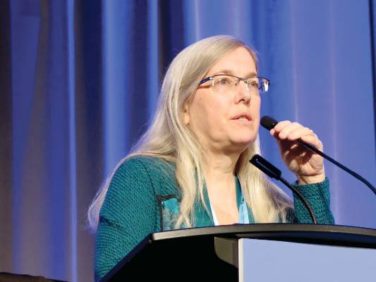AT LASER 2015
KISSIMMEE, FLA. (FRONTLINE MEDICAL NEWS) – Patients who received more local anesthesia before undergoing microwave-based treatment for axillary hyperhidrosis were happier with results and achieved the same objective improvements as patients who received less anesthesia, a follow-up study found.
“Patient satisfaction with the procedure was extremely high,” said Dr. Carolyn Jacob, a dermatologist and founding director of Chicago Cosmetic Surgery and Dermatology. “You can’t regenerate sweat glands – once they’re gone, they’re gone, and these patients have sustained results.”
The microwave system has been used commercially for more than 30,000 treatment sessions over 3 years and achieved high rates of efficacy and patient satisfaction in two pivotal trials, Dr. Jacob noted ( Dermatol. Surg. 2012;38:185-91 ; Dermatol. Surg. 2012;38:728-35 ).
But clinicians often have kept to the relatively low volumes of local anesthesia used in the trials because they were concerned that higher volumes would interact with microwave energy and diminish efficacy, she said at the annual meeting of the American Society for Laser Medicine and Surgery.
To investigate that concern and assess overall longer-term treatment outcomes, Dr. Jacob and her associates compared 110 patients who received 10-25 cc of local lidocaine/epinephrine solution per axilla (the amount used in the clinical trials) with 30 patients who received 60-275 cc per axilla before undergoing microwave-based treatment of hyperhidrosis. At baseline, the two groups scored similarly on the 4-point measure of hyperhidrosis severity and on 10-point measures of sweat and odor severity (average scores of 3.4, 8.5, and 5.2, respectively, for the group that received less anesthesia and 3.3, 8.7, and 5.8, respectively, for the group that received more anesthesia), said Dr. Jacob. Patients were treated at energy levels of 3-5, and most were female. The researchers followed the lower anesthesia group and the higher anesthesia group for an average of 6 and 9 months, respectively.
At follow-up, 88% of patients in the lower-volume anesthesia group scored 1 or 2 on the 4-point measure of hyperhidrosis, as did 93% of patients in the higher-volume group, said Dr. Jacob. The groups also had very similar efficacy results on the 10-point measures of sweat and odor severity, she said (respective average scores, 3.0 and 3.2 on the sweat measure, and 1.9 and 2.0 on the odor measure). In all, 85% of patients who received less anesthesia said they were satisfied with results, as did 93% of patients in the higher-volume group.
Patients usually needed two treatment sessions that lasted 60-75 minutes each, depending on the size of the treatment area, Dr. Jacob noted. A few needed only one session. “There’s a high efficacy that’s consistent with the previous publications we have,” she concluded. “The high volumes of anesthesia seem to work just as well as the lower volumes.”



